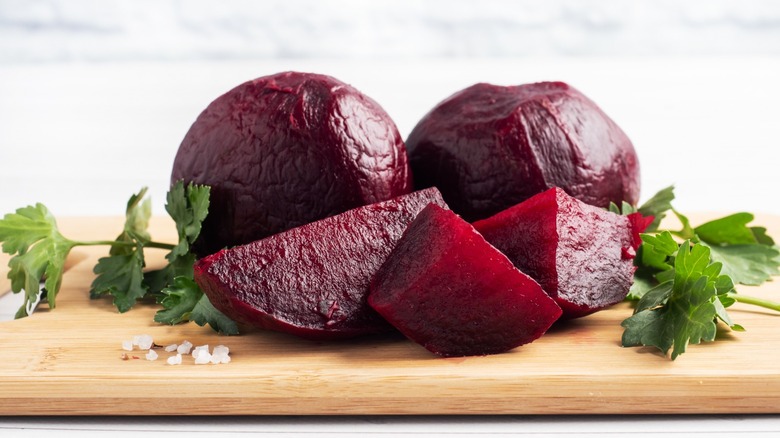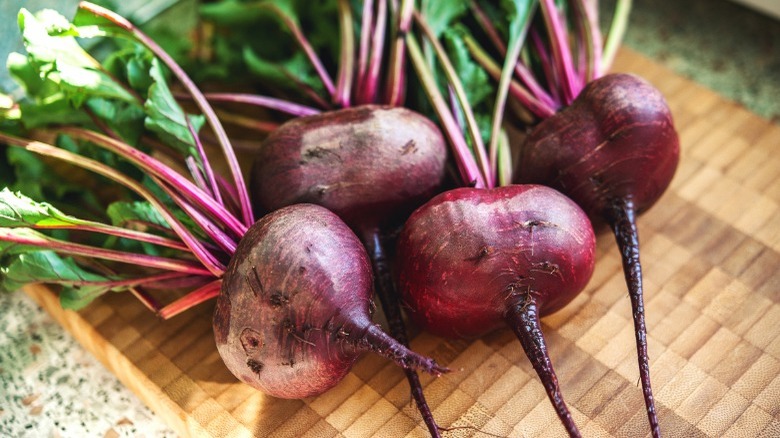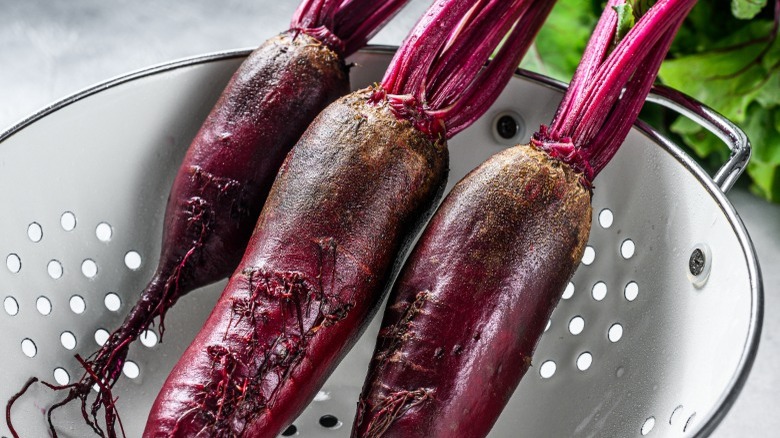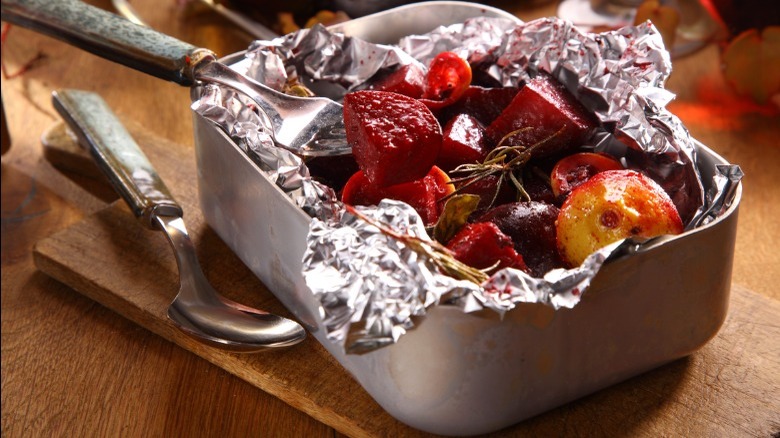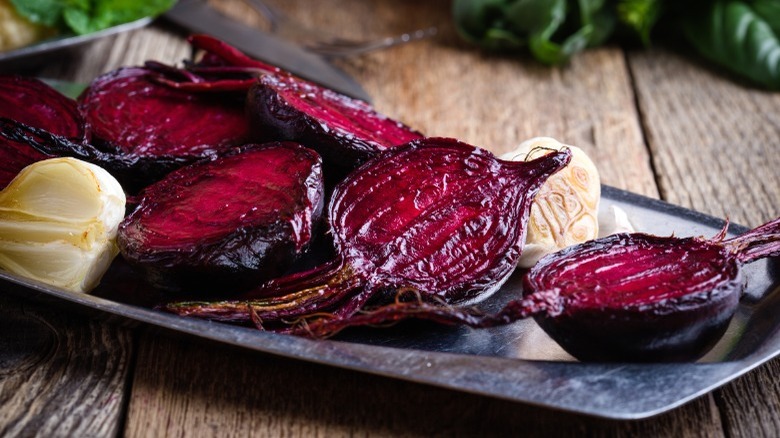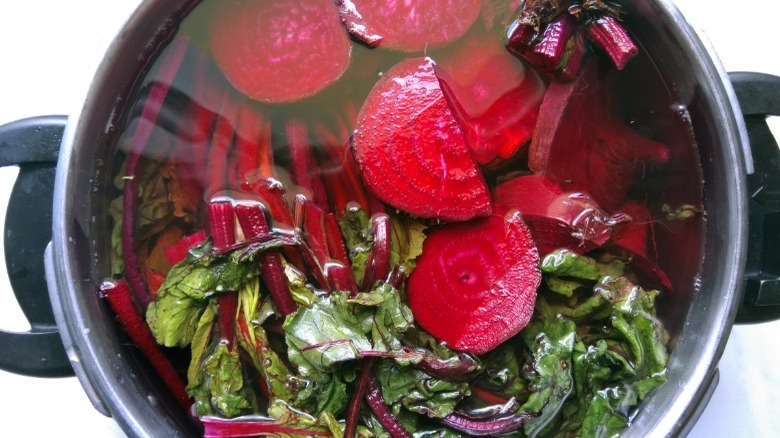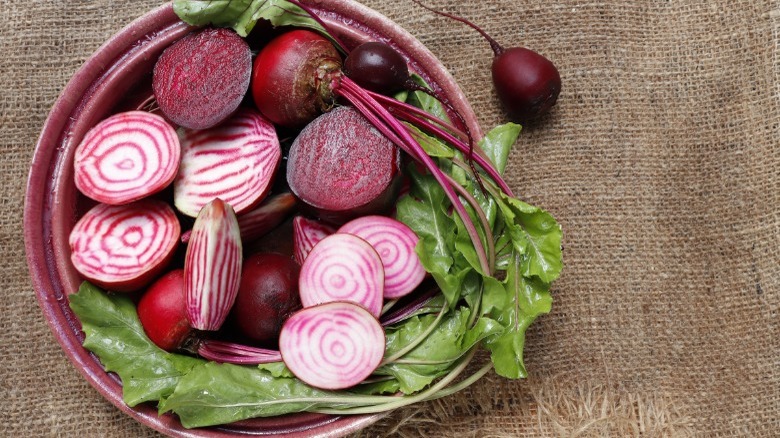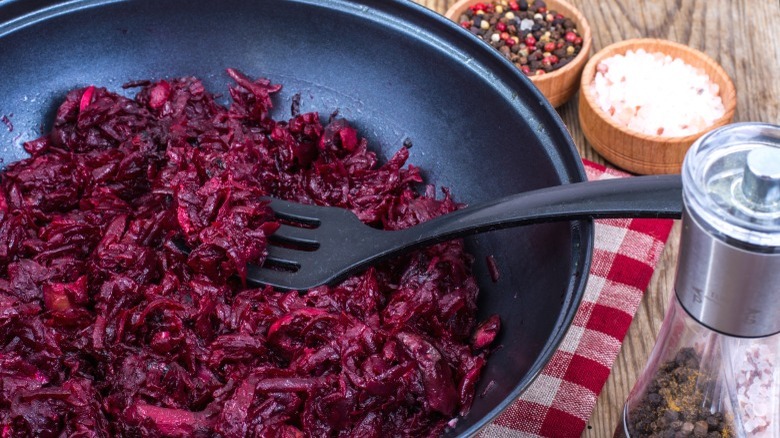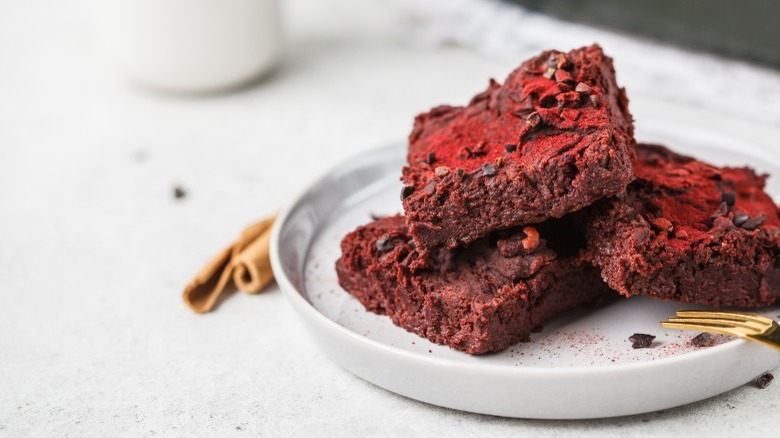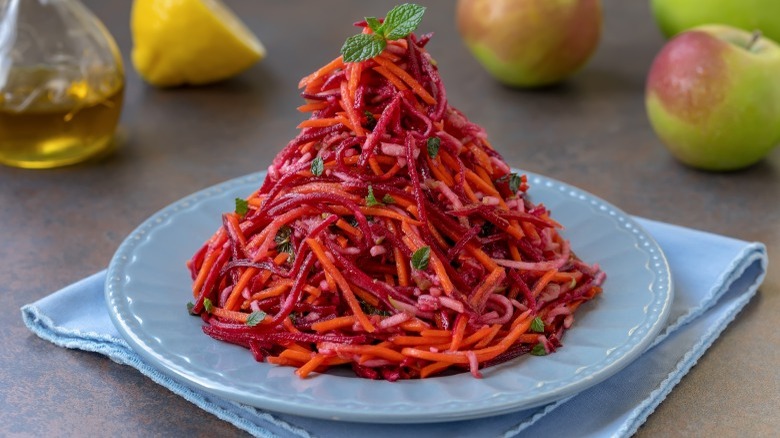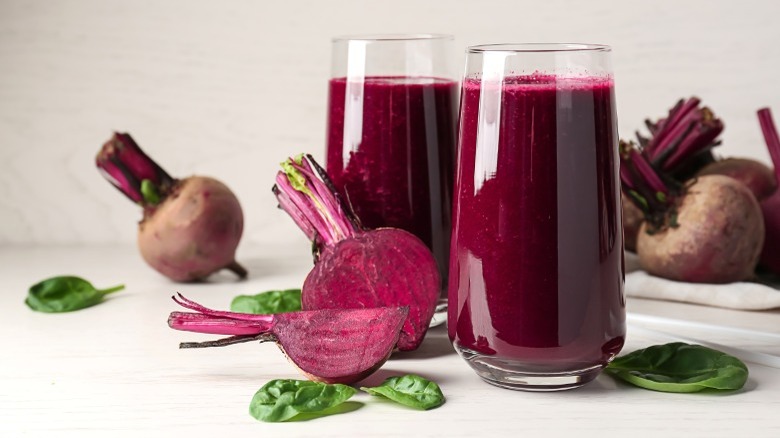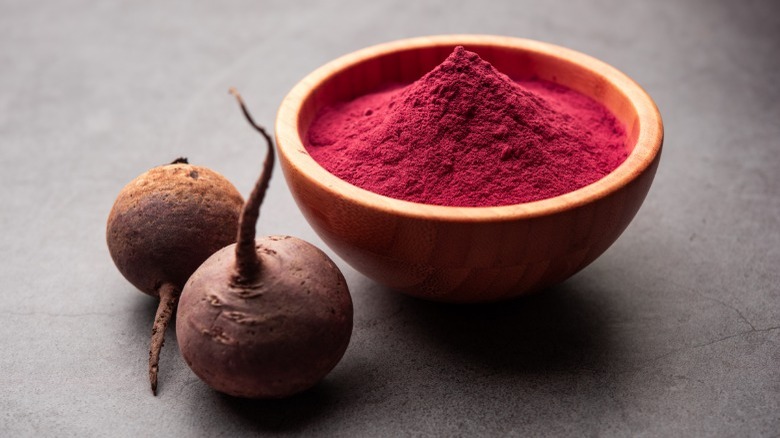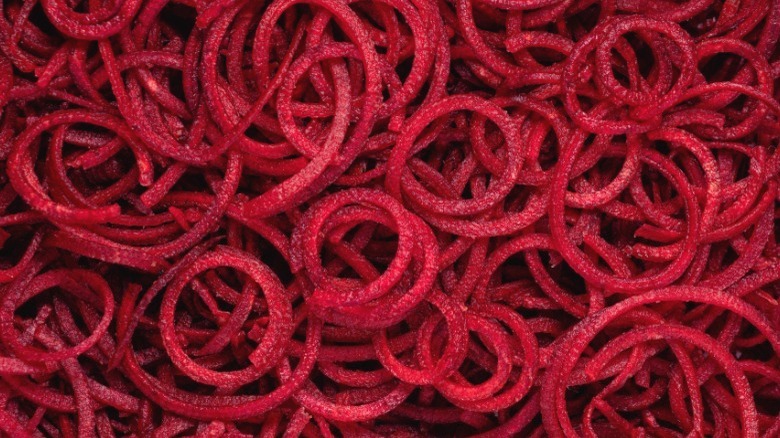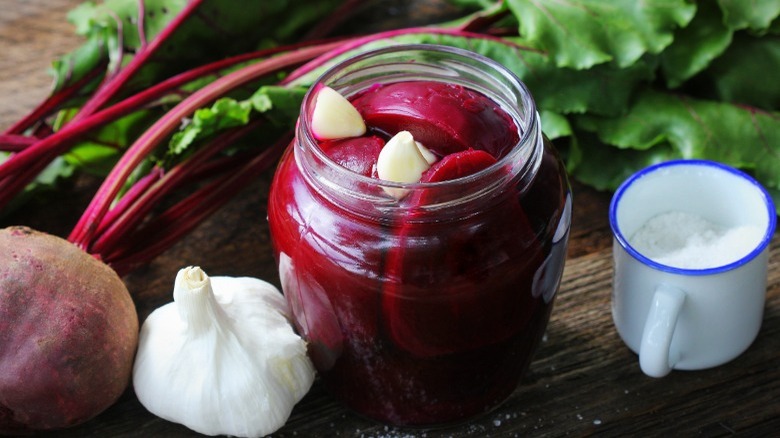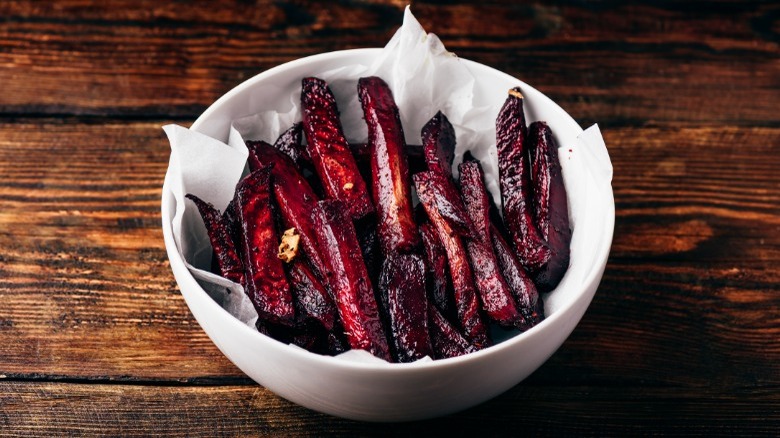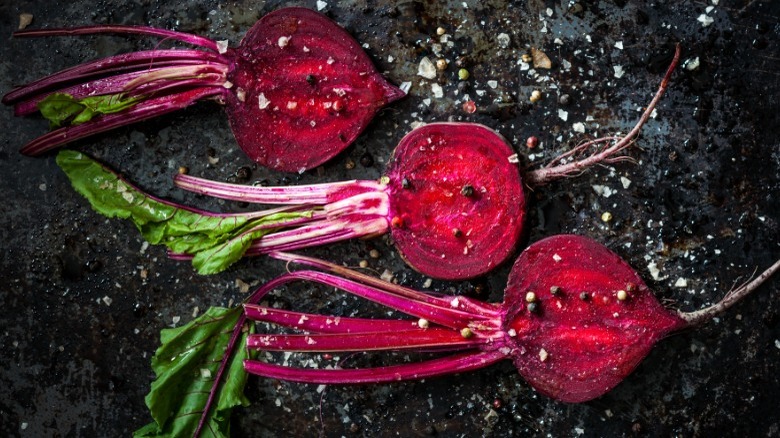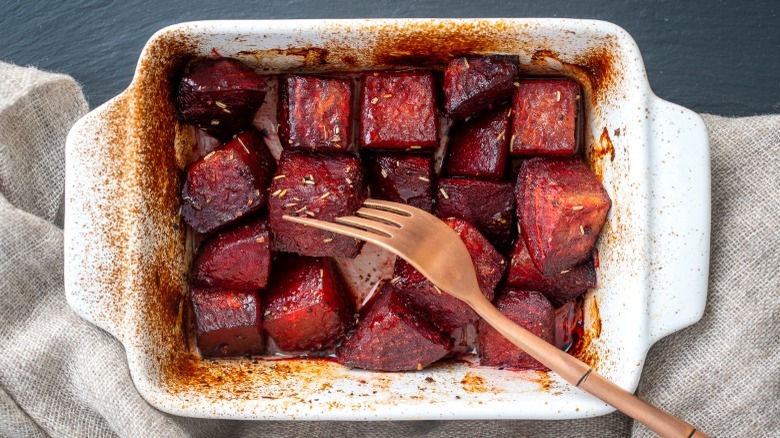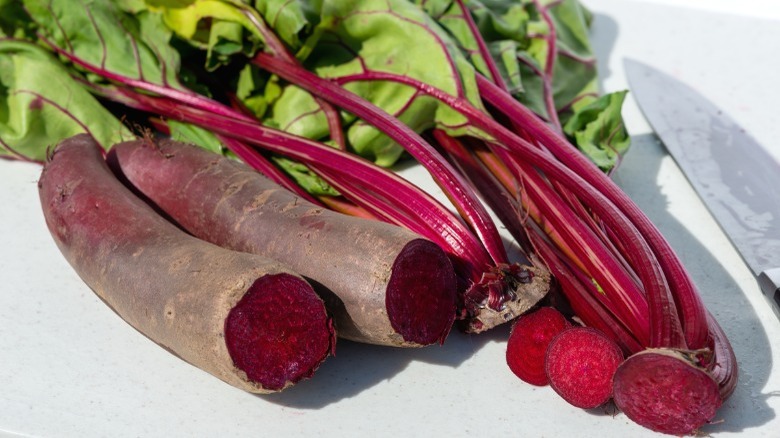17 Ways To Add More Flavor To Beets
They're messy, they're inconvenient, and they taste like dirt. As a result, they're one of the most hated vegetables in the U.S. And yet, under that thick, dirt-ridden skin, beets have so much to offer — it just takes a bit of skill and knowledge to uncover their potential. Both the bulbs and the greens are full of flavor and nutrients, and if you approach them with an open mind, they can become a vibrant, versatile addition to your diet.
One of the keys to maximizing the flavor of beets is to start with fresh, high-quality produce. Knowing what to look for when buying beets and how to store them properly can make a big difference in the final dish. Additionally, not all preparation methods require peeling, which can save time and add extra nutrients to your meals (not to mention making the dreaded cleanup easier). From roasting and grilling to adding spices and glazes, there are many ways to elevate the flavor of beets. Pairing them with acidic, sweet, and salty ingredients, as well as various spices, can alter your perception of the humble vegetable for the better. So whether you're looking for a savory side dish or a delectable sweet treat, there's a way to enjoy the rich flavor and nutrition of beets in a way that works for you.
Work with high-quality fresh beets
Whether cooking your beets or enjoying them raw, using fresh bulbs is the key to getting the best flavor. When buying fresh beets, pay attention to their size, color, and texture. First, the leaves are a great indicator of freshness, and they should be bright green and plump, and the bulbs should be a deep, rich color. But if the greens are removed, you can look for roots that are on the smaller side, firm, and smooth to the touch, with no soft spots.
Once you've brought your fresh beets home, proper storage techniques will help maintain their quality and flavor. The absolute best way to store beets is in the refrigerator, unwashed, in an airtight container covered with a damp paper towel. This way, you can store them for up to three weeks. Remember to remove the greens first — otherwise, they will keep drawing the flavor and moisture out of the root. Store them separately, and use them within a few days.
Stop peeling them
Messy and time-consuming prep is likely the reason you don't eat beets more often. However, you may be surprised to learn that, in some cases, it's not even necessary. That's right; you can skip the peeling process and still enjoy all the nutrients and flavor that beets have to offer. The skins of beets are entirely edible and contain essential nutrients like fiber, vitamin C, and various phytonutrients. Plus, they add a pleasant earthy flavor to your dishes.
The trick to never peeling beets again is to cook them with the skin on. That is especially true if you use an Instant Pot, which makes the skins so tender they're barely noticeable. If you insist on removing the skins, then you should wait to peel beets until they're cooked. Let them cool, and use a paper towel or your hands to rub the skin off. If the skin remains tough after cooking, a paring knife should help.
Roast beets in foil to keep them juicy
Unlike baked potatoes, beets really benefit from being roasted in foil. This method helps to bring out their natural sweetness by trapping moisture and caramelizing their natural sugars. In addition, the heat from the oven creates steam inside the foil packet, which helps to cook the beets evenly and keep them moist. The foil also prevents the beets from drying out and burning, allowing them to caramelize and intensify in flavor.
To make simple roasted beets, remove the greens and wash the bulbs while you preheat the oven to 400 degrees Fahrenheit. Then, simply wrap the beets in foil, place them on a baking sheet, and roast them in the oven until they're tender. This takes about 40-60 minutes; you can check them by piercing through the foil with a fork. As an added bonus, if you roast them whole, removing the skins gets significantly easier once they're done cooking and cooling.
Caramelize them on a grill
Roasting beets seems like the most common method to bring out their natural sweetness. However, there's one unconventional way to caramelize beets: firing up the grill and watching it do its magic. Not only does it intensify their candy-like flavor, but it also imparts a smokiness to them. Additionally, compared to oven-roasting, there's less waste when using the grill, as you won't need any tinfoil.
First, trim the leaves and roots off the beets, thoroughly wash the bulbs, then cut them into wedges or slices. Lightly brush them with oil, season with salt and pepper, and place the beets straight on the grill grates. Cook for about 10-15 minutes on each side or until tender and slightly charred. The key is to use indirect heat by placing the beets on the outer edges of the grill to prevent them from burning. You peel them beforehand or grill them with skins and remove them once they cool down.
Flavor the cooking water to mask the bitterness
This simple trick can elevate the overall taste of your beet dishes. The idea is to add some seasoning to the water in which the beets are boiled or steamed, which will help infuse the beets with additional flavor and reduce any unpleasant bitterness. Celebrity chefs swear by this method: for example, Geoffrey Zakarian's simple beets recipe that makes use of this technique has taken Instagram by storm. He recommends cooking them on medium heat for about an hour in a mix of water, red wine vinegar, salt, sugar, peppercorns, and coriander. Once cooked, he dresses them with sage olive oil, chardonnay vinegar, and some more salt and pepper, all of which complement and contrast the silky texture and sweet flavor of cooked beets. So, next time you boil beets, get creative with your cooking liquid and experiment with different seasonings to find the perfect flavor combination for your taste buds.
Mix different kinds of beets
Humans are visual creatures, so it's no surprise that the more impressive-looking a dish is, the more delicious we're likely to find it. Mixing different kinds of beets can introduce varying textures, colors, and flavors and make your dish more visually interesting. In addition to the tried-and-true red beets, there's a host of colorful varieties to choose from.
The most eye-catching of them all is undoubtedly the candy-striped beet. It has a distinct, vibrant pink and white striped pattern, and its flavor is more sweet and earthy than other varieties. Combined with other beets, it can intensify the dish's sweetness and add an interesting visual element to it. However, it's best to enjoy candy beets raw and thinly sliced, as cooking will negatively affect their appearance. A chewy beet salad is a great example of this. It combines roasted and dehydrated baby red beets with a beet juice vinaigrette dressing and a delicate candy beet garnish for a unique beet-eating experience.
Amplify different flavor notes with herbs and spices
Spices can be your secret weapon when working with beets, as they can help mask or intensify different aspects of their flavor. Warming spices like ginger, cinnamon, allspice, and cardamom all pair well with the earthy flavor of beets and can help enhance their natural sweetness. One example that takes advantage of this pairing is the cranberries with beets and cardamom recipe. It combines roasted beets with cranberries, red wine, beet greens, and warm spices for a delicious side dish. If you're actually a fan of the natural, earthy notes of beets, adding some cumin, coriander, dill, rosemary, or thyme toward the end of cooking can help emphasize this side of them. Finally, fresh mint and basil will make excellent beet companions in a salad.
Pair them with chocolate
Since these bulbous roots are most praised for their natural sweetness, adding them to desserts is the next logical step if you want to experience their full culinary potential. Combining them with chocolate serves a double purpose: not only does its bittersweet flavor pair well with its earthy, sweet notes, but it makes a great way to sneak more veggies into your diet. In addition, adding citrus fruit to the mix, as this chocolate, orange, and beet brownie recipe demonstrates, will further deepen the flavor.
While beets are notorious for dyeing everything they come in contact with, this can be masked in chocolatey desserts or taken advantage of in recipes like red velvet beet cake. The vibrant, naturally dyed cake layers are interspersed with rich chocolate caramel ganache, creating a show-stopping dessert. So, even if you're not a beet fan, incorporating them into desserts might just change your mind.
Eat them raw, dressed with vinaigrette
Whether cooked or raw, beets are rich in natural sugars that come forward when paired with acidic ingredients like citrus fruits and vinegar, which can help balance out their earthy flavor. This combination of sweet and tangy flavors is both refreshing and satisfying. One delectable example of this pairing is a spiralized beet salad with orange juice vinaigrette. In this recipe, the sweetness of red and yellow beets is complemented by the tangy acidity of the orange juice and white wine vinegar, which helps to tenderize the beets. The vinaigrette also includes Dijon mustard and shallots, adding a delicious piquancy to the dish. Additionally, using a spiralizer to cut the beets into thin, noodle-like strands adds an interesting texture, creating a feast both for the eyes and the tastebuds.
Mix them into a berry smoothie
Any nutritionist will tell you a perfect smoothie starts with using ingredients from multiple food groups. And while fruits and berries are usually the go-to ingredients, sweet vegetables deserve their place in the blender. So if you were looking for a creative way to capitalize on the beets' unique flavor and nutrition benefits, you should add these vibrant roots to smoothies. They are low in calories but high in fiber, folate, potassium, iron, and vitamin C. Beets are also rich in nitrates, which can improve blood flow and lower blood pressure (via Healthline). When blended into a smoothie, beets create a complex flavor profile and contribute a beautiful deep red color, so pairing them with berries and stone fruit is your best bet, presentation-wise. Alternatively, for a more vibrant flavor, process them with citrus fruit. You can also incorporate protein powder, nut butter, or seeds for added nutrition.
Dehydrate them to concentrate the flavor and preserve color
Dehydrating beets is a fantastic way to preserve their flavor and nutritional benefits while giving you more options to incorporate them into your diet. Doing so removes the bulbs' moisture, which helps concentrate their flavors and intensify their sweetness. One of the most popular dehydrated beet products is beet chips, and they make a healthy alternative to potato chips and can be used as a snack or a garnish for salads and other dishes. To make your own, slice beets thinly and combine them with the seasoning of your choice before placing them in the oven or a dehydrator until they become crispy.
Beet powder is another creative way to incorporate the benefits of beets into your diet. You can make your own by grinding dehydrated beets in a high-speed blender. As a natural food dye and flavoring agent, it can be added to smoothies, baked goods, and even savory dishes to give them a bright red color and a sweet, earthy flavor.
Spiralize them
Beetroot is an incredibly versatile vegetable that comes in many forms, and none is as fun to make as homemade beet noodles. If you're hesitant, let us explain why you need to be spiralizing beets. First, it makes for a visually stunning presentation with minimal effort. Second, prepping them this way creates more surface area, allowing for better sauce or dressing absorption. Plus, beet noodles can be eaten raw or cooked, giving you the flexibility to incorporate them into your favorite dishes. Finally, one large beet can make enough noodles to serve several people as a side dish, and it can even become a fun activity for the whole family. It's an excellent way to get children involved in the kitchen and excited about eating their vegetables. And with their beautiful, bright color, beet noodles can make any dish look more appealing. So if you own a spiralizer already, don't hesitate to work its magic on the humble beets.
Roast them before pickling
An average jar of homemade pickles is typically made with boiled beets, but roasting them is the hack you're likely missing out on. This extra step does not mean more work, however. Instead, by roasting whole beets in foil, you skip the messy step of peeling raw bulbs and allow them to develop a deeper, richer flavor compared to boiling. But if you're serious about your homemade beet pickling game, there's one more unexpected ingredient that will majorly upgrade it: ume plum vinegar. While this specialty ingredient isn't commonplace if you can get your hands on a bottle, put it to use in your favorite pickled beets recipe and see how it transforms it. Soft beet flesh marinates very quickly, and strong-flavored plum vinegar can further speed the process. Dress cooked beet wedges with a mix of vinegar, olive oil, garlic, salt, and pepper, and enjoy right away, or keep in the fridge for a week, incorporating them into various meals.
Deep fry them
If you've tried it all: roasting, boiling, grilling, steaming, dehydrating, and pickling, there's one more option left to exercise. While deep-frying beets might seem unconventional, it is still capable of adding more flavor to them. After all, everything tastes better deep-fried, and beets are no exception. The key to success here is using pre-cooked baby beets. The bulbs should be steam-roasted whole, have their skins removed, then battered and fried. Another step to enhance their flavor is letting them rest in an acidic marinade while you prepare the batter and heat up the oil. Alternatively, you could make crispy beet chips or fries by cooking them quickly at a high temperature to prevent them from becoming too soft. Finally, you can experiment with different coatings and seasonings to enhance the flavor.
Slow roast them in salt to preserve flavor
Slow-roasting beets in salt is a unique method of cooking beets that enhances their flavor and texture. The salt acts as a natural insulator, which helps to cook the beets evenly and gently. All you need to do is create a salt bed for them in a baking dish, roll them around on it, and let them rest under foil for 40-60 minutes at 425 degrees Fahrenheit. As the beets roast in the salt, they are infused with a subtle, salty flavor that complements their earthy sweetness. The salt also helps to draw any excess moisture out while locking the nutrients, flavor, and color in. Additionally, this technique creates a unique texture that is both tender and firm. The beets are not overcooked or mushy but rather have a slightly crisp exterior with a soft, tender interior. This texture is perfect for adding to salads, pureeing into a soup, or enjoying as a side dish.
Glaze them
Glazing beets is a surefire way to enhance both their taste and presentation, and we have collected some starting points for those looking to experiment with it. Pomegranate molasses and sea salt create a savory and tangy combination that can elevate the earthy flavor of beets, while an orange juice glaze adds a fruity and refreshing note that balances out their natural sweetness. On the other hand, the glossy balsamic vinegar and brown sugar create a rich, caramelized layer that complements the earthy flavor of beets. Candied beet recipes typically go for the same ingredients with the addition of butter. These glazes not only make the overall flavor more complex but also create an attractive shiny appearance, making them perfect for garnishing or as a side dish for any meal.
Don't let the greens go to waste
If you're looking to lower your food waste and add more nutrients to your diet, you need to stop throwing out the leafy tops the beets come with. Not only are beet greens edible, but they're also highly nutritious and have a culinary potential of their own. You'll find much of the same vitamins and minerals in the leaves as you would in the roots and more — they're rich in vitamins A and K, as well as calcium, potassium, riboflavin, and fiber.
Considering they're as unpretentious and versatile as Swiss chard or other leafy greens you're used to, including beet greens in your kitchen repertoire should be a breeze. Once you've thoroughly washed and dried them, you can use them in various ways: from oven-drying into chips to blending into a green smoothie to tossing them with some oil and garlic for an easy sautéed beet greens dish.
